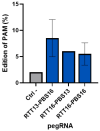In Vitro Correction of Point Mutations in the DYSF Gene Using Prime Editing
- PMID: 40565111
- PMCID: PMC12193300
- DOI: 10.3390/ijms26125647
In Vitro Correction of Point Mutations in the DYSF Gene Using Prime Editing
Abstract
Dysferlinopathy is caused by over 500 mutations in the gene encoding dysferlin, including close to 300 point mutations. One option to cure the disease is to use a gene therapy to correct these mutations at the root. Prime editing is a technique which can replace the mutated nucleotide with the wild-type nucleotide. In this article, prime editing is used to correct several point mutations in the DYSF gene responsible for dysferlinopathy. In vitro editing of HEK293T cells reaches up to 31%. Notably, editing was more efficient in myoblasts than in patient-derived fibroblasts. The prime editing technique was also used to create a new myoblast clone containing a patient mutation from a healthy myoblast cell line.
Keywords: CRISPR; LGMD; Miyoshi Myopathy; dysferlin; dysferlinopathy; gene therapy; point mutation; prime editing.
Conflict of interest statement
The authors declare no conflicts of interest.
Figures









Similar articles
-
Genome Editing of Monogenic Neuromuscular Diseases: A Systematic Review.JAMA Neurol. 2016 Nov 1;73(11):1349-1355. doi: 10.1001/jamaneurol.2016.3388. JAMA Neurol. 2016. PMID: 27668807 Free PMC article.
-
Epigenetic editing and epi-drugs: a combination strategy to simultaneously target KDM4 as a novel anticancer approach.Clin Epigenetics. 2025 Jun 19;17(1):105. doi: 10.1186/s13148-025-01913-0. Clin Epigenetics. 2025. PMID: 40537846 Free PMC article.
-
Artificial Intelligence in CRISPR-Cas Systems: A Review of Tool Applications.Methods Mol Biol. 2025;2952:243-257. doi: 10.1007/978-1-0716-4690-8_14. Methods Mol Biol. 2025. PMID: 40553337 Review.
-
Delivery of Prime editing in human stem cells using pseudoviral NanoScribes particles.Nat Commun. 2025 Jan 4;16(1):397. doi: 10.1038/s41467-024-55604-0. Nat Commun. 2025. PMID: 39755699 Free PMC article.
-
Selegiline for Alzheimer's disease.Cochrane Database Syst Rev. 2003;(1):CD000442. doi: 10.1002/14651858.CD000442. Cochrane Database Syst Rev. 2003. PMID: 12535396
References
-
- Straub V., Murphy A., Udd B., Corrado A., Aymé S., Bönneman C., de Visser M., Hamosh A., Jacobs L., Khizanishvili N. 229th ENMC international workshop: Limb girdle muscular dystrophies-Nomenclature and reformed classification Naarden, the Netherlands, 17–19 March 2017. Neuromuscul. Disord. 2018;28:702–710. doi: 10.1016/j.nmd.2018.05.007. - DOI - PubMed
MeSH terms
Substances
Grants and funding
LinkOut - more resources
Full Text Sources

